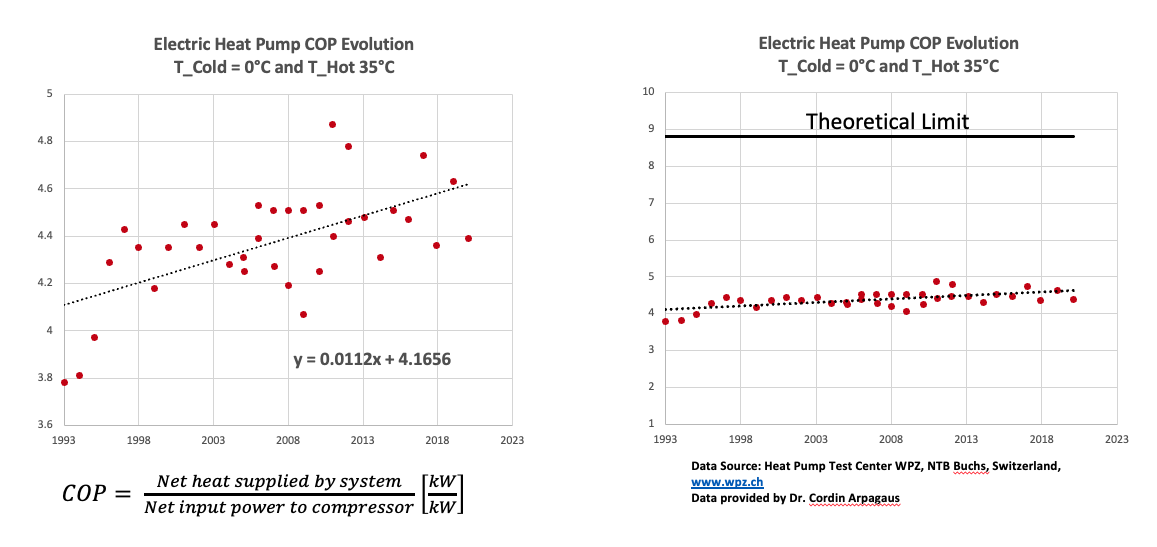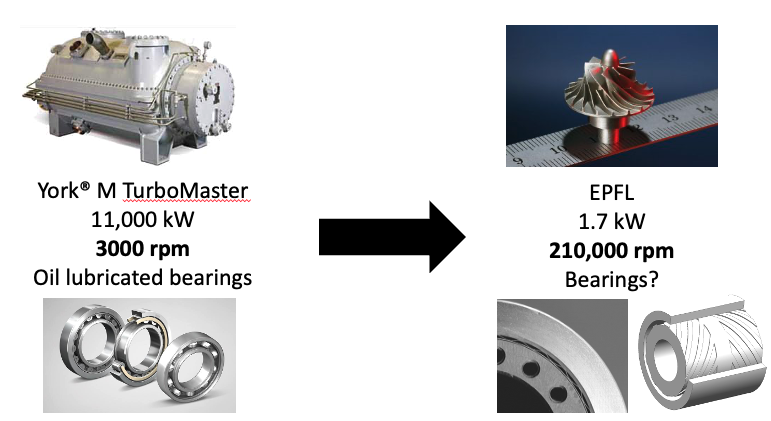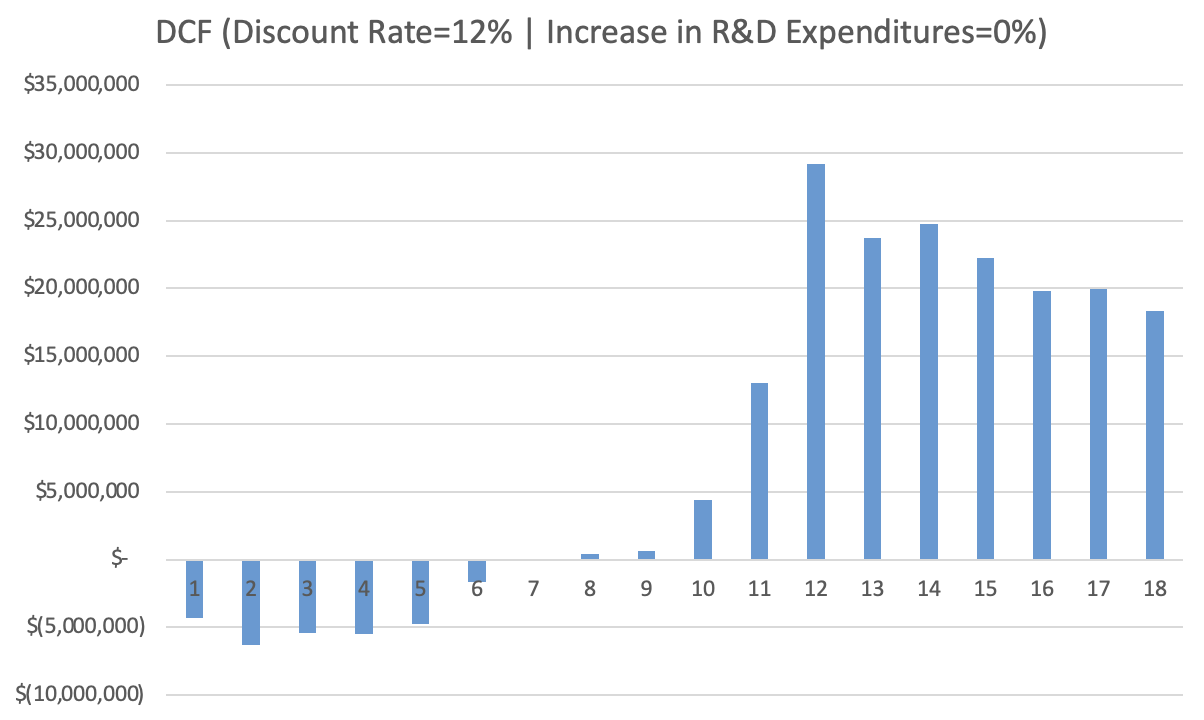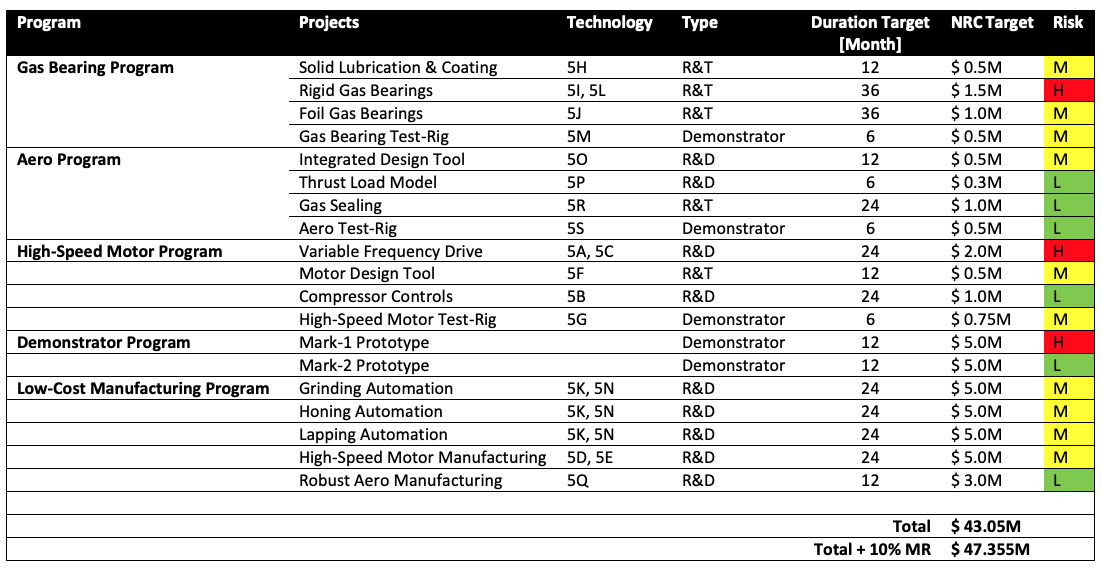Difference between revisions of "Electric Heat Pumps"
| Line 83: | Line 83: | ||
==Technical Model== | ==Technical Model== | ||
The figures depict the formula for the Coefficient of Performance (COP) for heating in a heat pump system, highlighting the impact of various component efficiencies on the overall COP. The COP is a measure of the heat pump's efficiency, calculated as the ratio of heating provided to the energy consumed | |||
[[File:Equation ks.png]] | [[File:Equation ks.png]] | ||
Revision as of 14:15, 6 December 2023
Roadmap Creators:
Time Stamp: 7 December 2023
Technology Roadmap Sections and Deliverables
- 2EHP - Electric Heat Pumps
The Electric Heat Pumps (EHP) roadmap is a level 2 roadmap at the product level, which is part of the level 1 roadmap for Electrification (1ELE). Levels 3 and 4 roadmaps would be subsystem and component roadmaps for Electric Heat Pumps (EHP).
Roadmap Overview
An electric heat pump spatially transfers heat from a low-temperature source to a high-temperature application. This process is based on the thermodynamics of the vapor compression refrigeration cycle, where the heat pump operates in a closed loop with a refrigerant fluid circulating within. In the "evaporator," the refrigerant fluid undergoes a phase change from liquid to vapor at a constant pressure, absorbing heat in the process. Following this, the "compressor" elevates both the pressure and temperature of the refrigerant, preparing it for the "condenser." Here, the refrigerant rejects the absorbed heat and transforms it back from a vapor to a liquid. Finally, an "expansion device" reduces the refrigerant's pressure and temperature back to the levels suitable for the "evaporator", completing the cycle and allowing it to commence anew.
Heat pumps have versatile applications, spanning various power scales and temperature lifts. These range from residential and commercial to industrial settings. The current dominant technology is fossil-fuel-burning boilers which are not sustainable environmentally and not strategic from an energy security perspective. This roadmap will focus on domestic heat pumps for designed residential applications in cold climates.
Design Structure Matrix (DSM) Allocation
The Design Structure Matrix (DSM) presented below is a strategic tool that showcases the interdependencies among various technologies and capabilities required for the development of a high-efficiency heat pump system. It highlights key capabilities such as robust gas bearing design tools and key technologies, such as high-frequency variable frequency drives, demonstrating how each element is interconnected and essential for the overall performance and competitiveness of the system. This DSM enables us to understand and manage the complexities of our technology development processes, ensuring that we can prioritize and sequence tasks effectively to achieve our innovation objectives.
Roadmap Model using OPM
This Object-Process Diagram (OPD) presents a structured overview of a heat pump system, detailing the operational flow and interdependencies between the components and processes involved. At its core, the system's operational objective is clear: to transfer heat from a low-temperature source to a high-temperature sink, a fundamental characteristic of heat pump technology.
Starting with the heat source, we see a process of temperature transformation, indicating that heat is processed and moved from a lower temperature to a higher one. This process flows into the operational heart of the system, the heat pump, which is detailed with various subprocesses like heating, cooling, compression, and expansion. Each subprocess is associated with specific components of the heat pump, such as the evaporator, compressor, condenser, and expander, which are standard in thermodynamic cycles.
The diagram further elaborates on the types of heat pumps—scroll, centrifugal, and piston—suggesting the system's adaptability to different technologies based on efficiency and application needs. Moreover, the OPD captures performance metrics such as the coefficient of performance (COP) and European Seasonal Energy Efficiency Ratio (ESEER), which are critical for evaluating the system's effectiveness and aligning it with energy efficiency standards.
Figures of Merit
When evaluating heat pumps, various figures of merit (FOMs) are crucial for assessing their efficiency, performance, and overall suitability for specific applications. These figures of merit provide a standardized way to compare different heat pump models and technologies. In order to identify those FOMs, a stakeholder analysis is performed to identify the key stakeholders and their needs. The tables below highlight such an analysis.
Each FOM is discussed in details below:
- COP (Coefficient of Performance): A measure of a heat pump's efficiency, indicating how much heat is produced for every unit of energy consumed. The higher the COP, the more efficient the heat pump.
- SEER (Seasonal Energy Efficiency Ratio): This ratio provides an indication of the seasonal energy efficiency of a heat pump, considering variations in climate and temperature throughout the year.
- ICO (Initial Cost of Ownership): This represents the upfront cost of purchasing and installing the heat pump system. It is usually expressed in cost per kilowatt ($/kW).
- Endurance: A reliability metric that estimates the average time between failures of the heat pump system. A higher ednurance indicates a more reliable system.
- Emissions: This refers to the annual CO2 emissions of the heat pump, usually measured in metric tons (MtCO2). It is an important measure for assessing the environmental impact of the system.
- GWP (Global Warming Potential): This figure measures the potential impact of the refrigerants used in the heat pump on global warming. It is a dimensionless ratio, where a lower GWP indicates a refrigerant with less impact on the environment.
- T_Lift (Temperature Lift): This measures the temperature increase that the heat pump can achieve between the evaporation and condensation stages. It is usually measured in degrees Celsius (degC) and indicates the heat pump's ability to raise the temperature from a lower to a higher level for heating purposes.
The top left figure above illustrates the improvement trend of the Coefficient of Performance (COP) for electric heat pumps over a span of approximately three decades, from the early 1990s to 2020 (Heat Pump Test Center WPZ, NTB Buchs, Switzerland, www.wpz.ch). The COP is an important figure of merit that indicates the efficiency of a heat pump at specific temperature conditions — in this case, when the cold side (T_Cold) is at 0°C and the hot side (T_Hot) is at 35°C. The top right figure highlights the theoretical limit which indicates the maximum possible COP as dictated by the Carnot efficiency, which is a theoretical limit based on thermodynamic principles. It also shows the large available room for improvement.
The figure above is exposing the first step change from screw compressor driven heat pumps to scroll compressor driven heat pumps in the early nineties. Since then the technology was improving slowly, the next step change improvement requires a different compression technology. Centrifugal compressors are a strong contender to deliver such value.
Alignment with Company Strategic Drivers
The table below highlights the alignment of the technology roadmap with the company's strategic drivers. It illustrates how the roadmap not only complements but is also in concordance with the company's core objectives. This alignment ensures that our technology initiatives are directly contributing to the company's overarching goals, thereby fostering a unified and strategic approach to innovation and growth within the organization.
Positioning of Company vs. Competition
In this section, we delve into the strategic placement of our company's products in the heating technology market. This analysis uses critical performance indicators and market trends to benchmark our offerings against those of our competitors. By evaluating factors such as ICO, efficiency metrics like COP and ESEER, environmental impact through annual emissions, and product reliability indicated by MTBF, we gain a comprehensive understanding of our competitive edge. The technologies listed range from various types of heat pumps — including Screw, Scroll, Rotary Vane, Reciprocating, and Vane — to traditional heating systems like gas-fired and oil-fired boilers, as well as electric heaters. The comparison illustrates significant variations in initial costs, with heat pumps generally being more expensive upfront than traditional boilers and electric heaters. However, the efficiency of heat pumps, as indicated by the COP and ESEER values, is significantly higher than that of gas-fired or oil-fired boilers and electric heaters.
This figure shows the trade-off between the COP and the ICO for various heating technologies. The COP at 100% load is plotted on the vertical axis, signifying the efficiency of each technology in converting energy to heat, while the horizontal axis represents the ICO, reflecting the initial investment required to purchase and install the technology. "Utopia," representing an ideal but unattainable state (currently) of highest efficiency at the lowest cost, and "Target," indicating the aspirational goal for our company that we aim towards.
Technical Model
The figures depict the formula for the Coefficient of Performance (COP) for heating in a heat pump system, highlighting the impact of various component efficiencies on the overall COP. The COP is a measure of the heat pump's efficiency, calculated as the ratio of heating provided to the energy consumed
The two pie charts provided illustrate key aspects of heat pump performance and costs, offering insights into where improvements could yield the most significant benefits.
The first chart, "Losses in a Heat Pump," indicates that 50% of heat pump losses come from compression. This is the largest segment, suggesting that the performance of the heat pump is highly sensitive to the efficiency of the compression process. Since losses in this area are substantial, enhancing compressor technology could lead to a more efficient heat pump with fewer losses, improving overall performance.
The second chart, "Cost Breakdown in a Heat Pump," shows that the compressor also accounts for the largest cost component at 35%. This further emphasizes the importance of the compressor, not only in terms of operational performance but also in the financial investment in heat pump technology.
Given that the compressor is both a primary source of energy loss and the most expensive component, it stands to reason that targeting technological advancements in compressor efficiency could provide dual benefits. By focusing development efforts on compression technology, manufacturers could potentially reduce both the operational costs by lowering energy losses, and the capital costs by creating more efficient and perhaps less expensive compressors.
Therefore, the data supports the conclusion that prioritizing improvements in compressor technology should be a strategic focus for optimizing heat pump systems, leading to better performance and cost-effectiveness.
Financial Model
In this section, we delve into quantitative analysis to evaluate the financial viability and potential returns of our technology. The financial model projects cash flows, considering the R&D projects (fixed cost), as well as the manufacturing costs (variable cost). We will use these projections to calculate key financial indicators such as Net Present Value (NPV), and payback periods for our technology.
The model is based on several assumptions summarized in the table below. The model assumes a high ramp up growth rate at first, which is expected in this industry, and that would continue for the first 6 years of production, after that, the demand and supply would saturate and will start growth by 8% annually. Moreover, we perform uncertainty analysis, changing two key inputs: demand and production cost.
The figure below shows the result of our analysis, each bar represents the present value of the cash flow at a given point in time, reflecting the profitability and viability of the investment under these specific conditions.
List of R&D Projects and Prototypes
This dependency matrix delineates the intricate network of technologies and capabilities required for the development of an electric heat pump system. By examining the interrelations from the perspective of Technology Readiness Level (TRL), we gain insight into the maturity and associated risks of each element.
In the subsequent analysis, we take a multifaceted view of each technology and capability, assessing them against TRL, and a complexity metric. Additionally, we consider the sourcing strategy, determining whether components should be developed internally or sourced externally. This comprehensive approach allows us to develop a strategic sourcing plan that aligns with our organizational capabilities and market position, ensuring that we leverage our strengths while mitigating risks associated with external dependencies.
Building on the preceding assessments, we have architected a series of targeted projects and aggregated them into coherent programs. Each program is designed to advance specific areas of our heat pump system, from gas bearing design to high-speed motor development. This structuring enables us to allocate resources effectively, track progress methodically, and drive innovations in a focused manner, with clear timelines, cost estimates, and risk assessments for each project within the program.
Key Publications, Presentations and Patents
Welch et al. (2013). Motor Cooling Applications (US 8,434,323 B2). U.S. Patent and Trademark Office. This patent is from Johnson Controls, a prominent figure in the HVAC market, specializing in heat pumps and chillers. The patent details a cooling method that utilizes refrigerant fluid to directly cool the compressor's rotor. This technique potentially enables the compressor to rotate at faster speeds, producing higher pressures. Consequently, this could lead to elevated temperatures for heat pump applications, as well as, allows for smaller compressors where thermal management is a key hurdle. The patent is expired, the concept can be adopted in future use.
Canino et al. (2023). Solar Integrated Chiller Method and System (US 11,761,688 B2). U.S. Patent and Trademark Office. Smardt Chillers, a leading innovator in the field of high-efficiency chillers and heat pumps, has patented an integration of PV solar panels with an air-cooled chiller system. The design harnesses solar panels to provide power to auxiliary and balance-of-plant components within a typical chiller or heat pump configuration. This design increases the overall efficiency of the heat pump. Furthermore, with an adequately dimensioned PV array, the system has the potential to operate autonomously, both grid-tied and off-grid. The patent is recently granted.
Geyer et al. (2016). Method for Controlling Harmonics and Resonances in an Inverter (US 9,385,585 B2). U.S. Patent and Trademark Office. This is a patent by ABB, a global market leader in machinery, controls, and power electronics. The patent presents a method to control and mitigate harmonic distortions in inverters of electrical systems. By determining voltage vector sequences, evaluating their effects on the system, and using optimal sequences, the invention aims to enhance inverter efficiency and reduce harmful resonances. By controlling harmonic distortions in inverters, this invention can significantly improve the overall efficiency of centrifugal heat pumps driven by variable speed compressors. The patent is due to expire in 3 years.
Technology Strategy Statement
The technology strategy for the depicted roadmap is focused on achieving a groundbreaking Residential Oil-Free Centrifugal Heat Pump system by the year 2032. Our journey begins with the development of an optimized aerodynamic design in 2026, setting the foundation with enhanced efficiency and reduced noise. By 2027, we aim to integrate advanced gas bearing technology, a key enabling technology that ensures an extended lifespan for the heat pump. Progressing towards 2028, our focus will shift to incorporating in-house high-speed motor capabilities, which is expected to deliver superior performance and reliability.
The subsequent years will see us develop and test Mark-1 and Mark-2 demonstrators. These will be pivotal in demonstrating the viability and benefits of the innovations we are implementing. The culmination of our efforts will be realized in 2032 with the launch of the residential oil-free centrifugal heat pump, which promises to revolutionize the market with its exceptional efficiency and cost-effectiveness.
Throughout this period, our strategy also emphasizes the adoption of low-cost manufacturing technology, ensuring that our advanced heat pump system remains affordable and accessible to a broad consumer base. This balanced approach between high-tech advancements and cost management is fundamental to our commitment to sustainability and innovation.
References
TBD
























